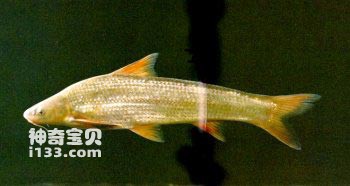Coreius heterodon belongs to the order Cypriniformes, family Cyprinidae, subfamily Coreius heterodon, and genus Coreius heterodon. Commonly known as: pointed head, water dense child, pointed stick, pointed water dense child, retreating loach, fake fat tuo, twist fish, orange stick, bamboo fish, yellow Taoist, copper coin buckle, golden loach. English name: Brass gudgeon, Bronze gudgeon.
The body is slender, the front end is round and rod-shaped, and the rear end is slightly flattened laterally. The head is small and tapered; the eyes are small; the mouth is located downward, narrow and horseshoe-shaped; the head length is 7-9 times the width of the mouth. The ends of the hypopharyngeal teeth are slightly hook-shaped; there is one pair of barbels, and the ends exceed the posterior edge of the eye. The pectoral fins extend backward and do not reach the starting point of the pelvic fins. The body is brassy in color and each fin is light yellow.

Bronze fish inhabit the lower layers of river water environments and are accustomed to swimming in groups. Usually a group consists of dozens to hundreds of individuals. In winter, it overwinters in the gaps between rocks in deep river channels or deep pools. The age of sexual maturity is 2-3 years old, and the reproductive period is 4-6 months. They mostly breed in river sections with fast currents. The fertilized eggs drift and develop with the river water, and the number of eggs they can carry is 20,000-200,000. Copperfish feed intensively and their intestines are often filled with food. Its food composition mainly consists of freshwater shell vegetables, clams, snails and molluscs, followed by higher plant fragments and some diatoms. It is an omnivorous fish. Its fry and young fish eat the fry of other fish and are extremely gluttonous, making them one of the biggest enemies of domestic fish fry.
Copper fish are mostly found in the main branches and tributaries of the Yangtze River Basin and lakes with flowing water; they are relatively rare in still water lakes.
Another round-mouth bronze fish (Coreius guichenoti) in the Yangtze River is commonly known as Fat Tuo, Square-headed Water Mizi, and its English name is Largemouth bronze gudgeon. Its morphological difference is that its mouth is wide and arc-shaped; its whiskers can reach the base of the pectoral fin. The pectoral fins extend far beyond the base of the pelvic fins. The living habits of this fish are similar to those of copper fish, but its distribution is mainly in the upper reaches of the Yangtze River, and less in the middle reaches.
The Northern bronze gudgeon (Coreius septentrionalis) produced in the Yellow River is commonly known as: pigeon fish, sharp-billed water dense fish, and its English name: Northern bronze gudgeon. The difference from ordinary copper fish is that the mouth is wider, the head length is less than 6 times the width of the mouth, and the ends of the hypopharyngeal teeth are beveled. Their living habits are similar to ordinary copper fish, but their distribution is limited to the Yellow River.
Copper fish grows rapidly, and its natural output in the Yangtze River and Yellow River is very high. The average individual weight is 0.5-1 kg, and the largest one reaches 3.5-4 kg. It is extremely abundant in the upper reaches of the Yangtze River, the upper reaches of the Han River and the Qingyuan area of the Yellow River Basin, and is an important economic fish. Copper fish has tender meat, plump taste, rich body fat and few bone spurs, so it is classified as a top-quality fish. Especially in the Yellow River Basin, pigeon fish has long been famous and is regarded as a precious specialty fish locally. The copper fish spawn in groups every year and enter the tributaries to feed and fatten. From August to September, they gradually return to the main stream or find a place to overwinter in the tributaries. At this time, the copper fish are the most fat and fat, and fishermen often call them "retreating loaches".
animal tags:
We created this article in conjunction with AI technology, then made sure it was fact-checked and edited by a Animals Top editor.